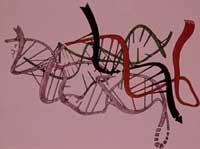Molecule that helps the cell read the genome

The information to form proteins is not always organized in the DNA chain. The problems and swings of evolution have interspersed in many genes purely genetic information. They are code breaks, holes, and biochemists have called it intron. The gene information is fragmented and each fraction is called exon. In order to read the complete information of a gene, it is necessary to jump from one exon to another until you find the final signal.
Sometimes the cell does not identify introns and exones and produces defective proteins. In many cases, this causes serious diseases such as BRCA1, which causes breast cancer.
Introns should be identified in a copy of the DNA molecule, RNA. Introns are also copied into the RNA chain, so they must be found and cut. To do this, the cell uses the SR protein. This protein looks for the beginning and end signals of all introns and cuts the piece of code without information. The problem arises when there are mutations in these signals. If the signal is altered, the SR protein does not find introns and misinformation is used, that is when the disease occurs.

Now, Americans Luca Cartegni and Adrian Krainer have found a way to solve this problem for the BRCA1 and SMN2 genes. These genes are related to breast cancer and a spinal atrophy respectively.
In both cases, a very complex molecule consisting of two main parts has been synthesized: one of them looks like RNA and the other like SR. This molecule detects an error and helps the SR protein identify the signal. Even in very small amounts, the molecule succeeds.
In view of this success, the next step of biochemists will be to find how to introduce the molecule into the cells to make it a medicine that allows it to be transported as far as necessary.
Buletina
Bidali zure helbide elektronikoa eta jaso asteroko buletina zure sarrera-ontzian











